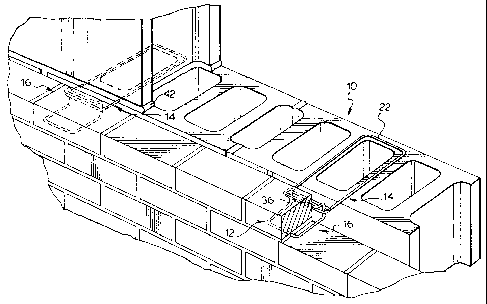Une partie des informations de ce site Web a été fournie par des sources externes. Le gouvernement du Canada n'assume aucune responsabilité concernant la précision, l'actualité ou la fiabilité des informations fournies par les sources externes. Les utilisateurs qui désirent employer cette information devraient consulter directement la source des informations. Le contenu fourni par les sources externes n'est pas assujetti aux exigences sur les langues officielles, la protection des renseignements personnels et l'accessibilité.
L'apparition de différences dans le texte et l'image des Revendications et de l'Abrégé dépend du moment auquel le document est publié. Les textes des Revendications et de l'Abrégé sont affichés :
| (12) Brevet: | (11) CA 2363236 |
|---|---|
| (54) Titre français: | ATTACHE DE MUR SIMPLE |
| (54) Titre anglais: | SINGLE-END WALL TIE |
| Statut: | Durée expirée - au-delà du délai suivant l'octroi |
| (51) Classification internationale des brevets (CIB): |
|
|---|---|
| (72) Inventeurs : |
|
| (73) Titulaires : |
|
| (71) Demandeurs : |
|
| (74) Agent: | GOWLING WLG (CANADA) LLP |
| (74) Co-agent: | |
| (45) Délivré: | 2009-03-24 |
| (22) Date de dépôt: | 2001-11-16 |
| (41) Mise à la disponibilité du public: | 2002-05-20 |
| Requête d'examen: | 2006-11-09 |
| Licence disponible: | S.O. |
| Cédé au domaine public: | S.O. |
| (25) Langue des documents déposés: | Anglais |
| Traité de coopération en matière de brevets (PCT): | Non |
|---|
| (30) Données de priorité de la demande: | ||||||
|---|---|---|---|---|---|---|
|
Attache murale ajustable pour fixer des parois de mur espacées, comme une paroi de maçonnerie plaquée, à un mur de structure en maçonnerie formé de blocs. L'attache murale comprend un ancrage de tension et un crochet en forme de J pour créer une tension permettant l'ajustement vertical.
An adjustable wall tie for securing together spaced wythes such as a masonry veneer wall to a structural masonry wall of block-like construction. The wall incudes a tension anchor and a generally J-shaped single-ended hook adapted to engage the tension for vertical adjustment.
Note : Les revendications sont présentées dans la langue officielle dans laquelle elles ont été soumises.
Note : Les descriptions sont présentées dans la langue officielle dans laquelle elles ont été soumises.

2024-08-01 : Dans le cadre de la transition vers les Brevets de nouvelle génération (BNG), la base de données sur les brevets canadiens (BDBC) contient désormais un Historique d'événement plus détaillé, qui reproduit le Journal des événements de notre nouvelle solution interne.
Veuillez noter que les événements débutant par « Inactive : » se réfèrent à des événements qui ne sont plus utilisés dans notre nouvelle solution interne.
Pour une meilleure compréhension de l'état de la demande ou brevet qui figure sur cette page, la rubrique Mise en garde , et les descriptions de Brevet , Historique d'événement , Taxes périodiques et Historique des paiements devraient être consultées.
| Description | Date |
|---|---|
| Inactive : Périmé (brevet - nouvelle loi) | 2021-11-16 |
| Requête pour le changement d'adresse ou de mode de correspondance reçue | 2021-03-29 |
| Requête pour le changement d'adresse ou de mode de correspondance reçue | 2021-03-19 |
| Demande visant la révocation de la nomination d'un agent | 2021-03-19 |
| Demande visant la nomination d'un agent | 2021-03-19 |
| Requête pour le changement d'adresse ou de mode de correspondance reçue | 2021-03-19 |
| Représentant commun nommé | 2019-10-30 |
| Représentant commun nommé | 2019-10-30 |
| Requête pour le changement d'adresse ou de mode de correspondance reçue | 2018-01-16 |
| Accordé par délivrance | 2009-03-24 |
| Inactive : Page couverture publiée | 2009-03-23 |
| Préoctroi | 2009-01-07 |
| Inactive : Taxe finale reçue | 2009-01-07 |
| Un avis d'acceptation est envoyé | 2008-12-03 |
| Lettre envoyée | 2008-12-03 |
| Un avis d'acceptation est envoyé | 2008-12-03 |
| Inactive : Approuvée aux fins d'acceptation (AFA) | 2008-11-27 |
| Modification reçue - modification volontaire | 2008-09-15 |
| Inactive : Dem. de l'examinateur par.30(2) Règles | 2008-08-28 |
| Déclaration du statut de petite entité jugée conforme | 2007-11-16 |
| Requête visant une déclaration du statut de petite entité reçue | 2007-11-16 |
| Lettre envoyée | 2006-11-28 |
| Requête d'examen reçue | 2006-11-09 |
| Exigences pour une requête d'examen - jugée conforme | 2006-11-09 |
| Toutes les exigences pour l'examen - jugée conforme | 2006-11-09 |
| Inactive : CIB de MCD | 2006-03-12 |
| Demande publiée (accessible au public) | 2002-05-20 |
| Inactive : Page couverture publiée | 2002-05-19 |
| Inactive : CIB attribuée | 2002-01-24 |
| Inactive : CIB en 1re position | 2002-01-24 |
| Demande reçue - nationale ordinaire | 2001-12-18 |
| Lettre envoyée | 2001-12-18 |
| Inactive : Certificat de dépôt - Sans RE (Anglais) | 2001-12-18 |
| Déclaration du statut de petite entité jugée conforme | 2001-11-16 |
Il n'y a pas d'historique d'abandonnement
Le dernier paiement a été reçu le 2008-11-12
Avis : Si le paiement en totalité n'a pas été reçu au plus tard à la date indiquée, une taxe supplémentaire peut être imposée, soit une des taxes suivantes :
Les taxes sur les brevets sont ajustées au 1er janvier de chaque année. Les montants ci-dessus sont les montants actuels s'ils sont reçus au plus tard le 31 décembre de l'année en cours.
Veuillez vous référer à la page web des
taxes sur les brevets
de l'OPIC pour voir tous les montants actuels des taxes.
Les titulaires actuels et antérieures au dossier sont affichés en ordre alphabétique.
| Titulaires actuels au dossier |
|---|
| BLOK-LOK LIMITED |
| Titulaires antérieures au dossier |
|---|
| KENNETH G. BANKS |
| WILLIAM S. BURNS |